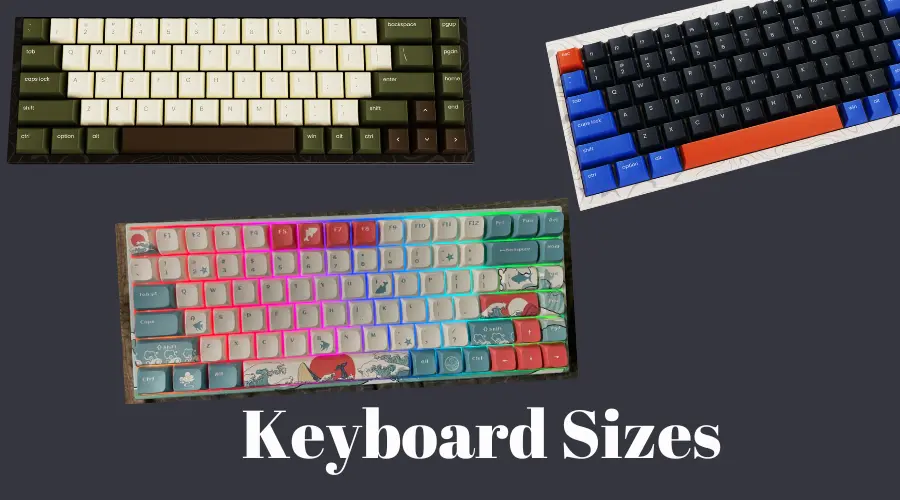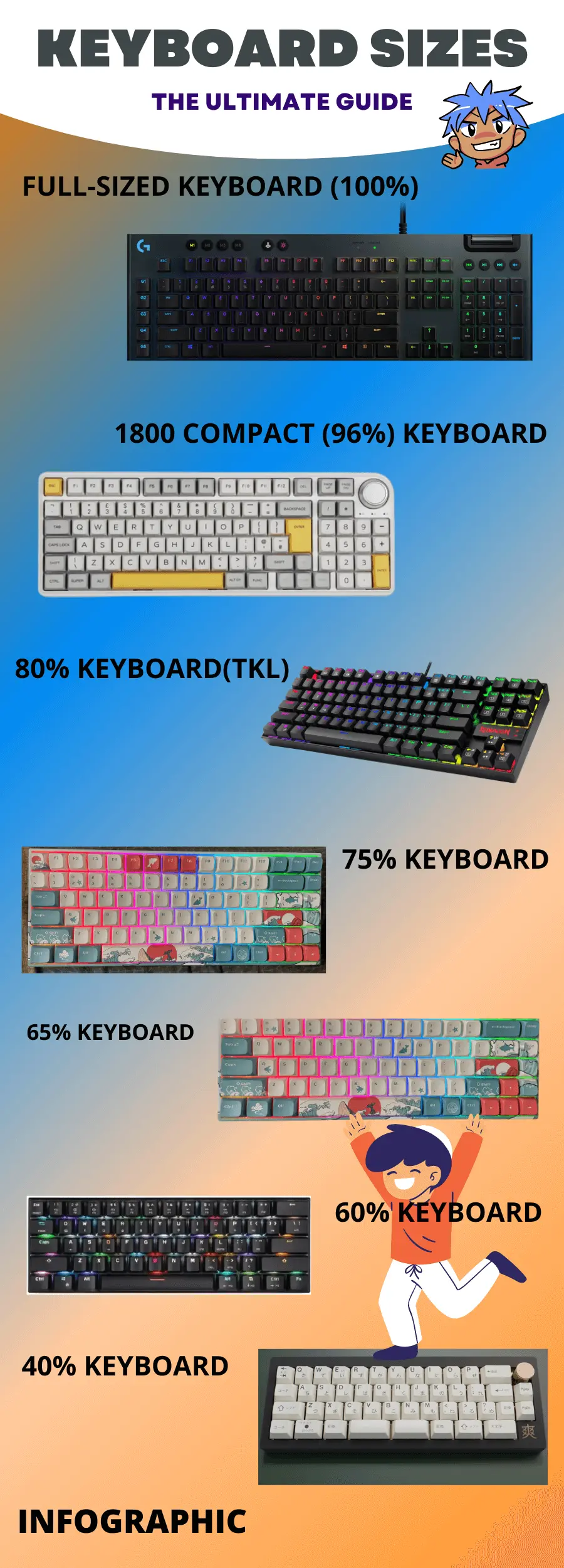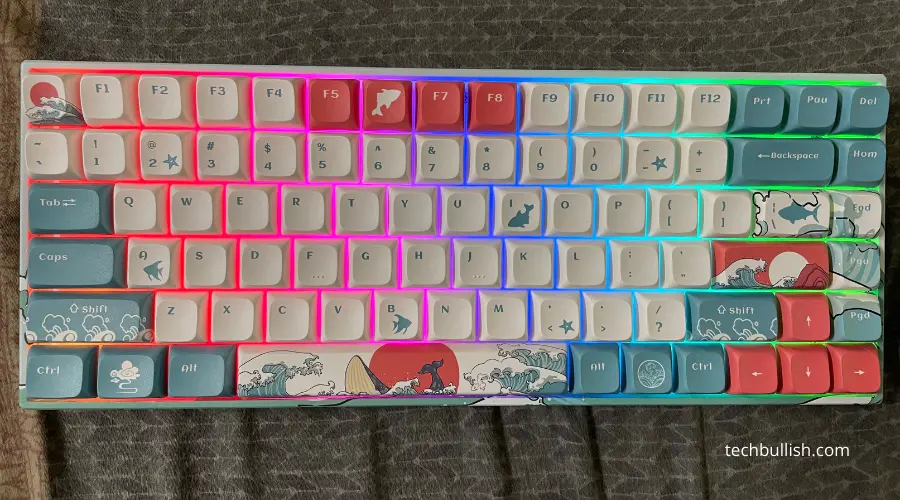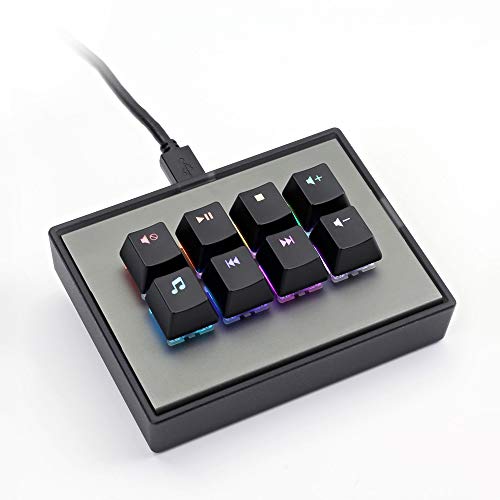When it comes to choosing a mechanical keyboard, size does matter. Depending on your needs, you may prefer a compact keyboard that takes up less space on your desk.
You may prefer a full-size keyboard with a numeric keypad for working with spreadsheets and other data-heavy applications.
In this article, we’ll take a look at the different Keyboard sizes available and help you to know about them in detail.

Let’s get started!
Keyboard sizes
Here are the different mechanical keyboard sizes:

1. Full-Sized Keyboard (100%)
Total Number of Keys: 104 (E.g., Corsair K60 Keyboard with 104 keys)
There are a variety of keyboard sizes available on the market. The most common size is the full-sized keyboard. A full-sized keyboard offers a comfortable, natural typing experience.
It also provides a more efficient way to type, as your fingers don’t have to travel as far to reach the keys. And if you’re a touch typist, a full-sized keyboard can help you maintain your speed and accuracy.
The keyboard has a standard layout that includes a numeric keypad, and it is also spill-resistant.
2. 1800 Compact (96%) Keyboard
Total Number of Keys: 103-104
1800 Compact Keyboard is the perfect keyboard for your office or home. The keyboard has a small, sleek design that will save you valuable desk space.
The keyboard also features an ergonomic design to make typing more comfortable.
With its low profile and slim design, the 1800 Compact Keyboard is easy to transport and store.
3. Tenkeyless(TKL) Keyboard
Total Number of Keys: 87, E.g., Drop CTRL Tenkeyless Mechanical Keyboard
If you’re in the market for a new keyboard, you’ve likely heard about the Tenkeyless Keyboards.
What is it?
It’s a computer keyboard that’s designed without the traditional number pad and function keys.
Some users find that this minimalist layout is more efficient for their typing since they don’t have to move their fingers to change letters. Here are the main advantages of this type of keyboard.
TKL keyboards are 80% keyboards and smaller than traditional keyboards.
They come with no dedicated number pad keys. Instead, you’ll find 87 or 88 keys, and the arrow keys are directly below the enter key.
Moreover, the home cluster is placed vertically next to the backspace and enter keys. The 75% model also has no dedicated numeric pad keys.
For those who like to have fewer keys, the TKL mechanical keyboard is a great option.
4. 75% Keyboard
Total number of Keys: 84. (E.g. XVX M84 which is a 75% keyboard has 84 keys. This is my current mechanical keyboard.)

The seventy-five percent (75%) keyboard size is more compact and easier to use than a full-sized keyboard.
The design is similar, but the arrow keys, F-keys, and number pad have been moved to more convenient locations.
The keys are also close together, making the keyboard easier to carry around and taking up less space on a desk.
Most laptops come with a 75% keyboard, which eliminates the gap between the keys and crams them in like a chocolate bar.
A typical seventy-five percent keyboard has 80-84 keys, with dedicated arrow keys and a function row.
Most 65% of keyboards lack the F key cluster and a portion of the control keys.
The keyboard layout is centered on the function row, which acts as a multitool. Several applications make use of these keys.
This configuration is the most popular for gaming, but it may be awkward for everyday use.
5. 65% Keyboard
Total number of Keys: 68 (E.g. The RK ROYAL KLUDGE RK68 has 68 keys)
65% of keyboards come under compact-size keyboards. Now, in most places, you will find a 65% keyboard being used.
It eliminates the keys like Function Keys, Navigation Keys, Numpad Keys, and arrow keys to come in a compact size.
Here you won’t find the Numpad on the right of the keyboard.
6. 60% Keyboard
Total Number of Keys: 61. (E.g., HK Gaming GK 61 has 61 keys.)
The 60% keyboard is a great tool for people who want to get more work done in a very compact size. The keyboard has a lot of great features that make it easy to use.
When building a custom keyboard, 60% of keyboards are one of the most common sizes.
You can customize a 60% keyboard with a different color scheme and case material, and use a variety of switches and keycaps.
7. 40% Keyboard
Total Number of Keys: 40-44.
When you want to save space on your desk, the 40% Keyboard may be the best option for you. This keyboard features a small, sleek design and is portable.
This keyboard will fit into a small backpack or a small pocket. Its slim size facilitates easy key placement and has very lightweight, making it a great option for travel.
The 40 percent keyboard’s size is a nice compromise between portability and functionality.
8. Number Pad
Total Number of Keys: 17-21. (E.g., Darmoshark Mechanical Numeric Keypad has 21 keys whereas the NACODEX AK18 2.4GHz Wireless Numeric Keypad has 17 keys)
A number pad is a handy tool to have when you need to enter numbers into a form or document. They typically have a key for each number 0-9, and some also include a symbol key.
Some number pads also have a 10-key feature, which can be helpful for data entry or accounting work.
9. Macro Pad
Total Number of Keys: 8-16.
Macros are great for saving time when performing repetitive tasks. You can map multiple actions to the same key, making typing a breeze.
Common uses of macro pads include copy and paste and CTRL-ALT-DELETE. The possibilities are as endless as your imagination. Some people find macros very helpful, while others prefer to do things manually.
Why are there keyboard Sizes?
The keyboard has everything you need, but it’s possible to use something smaller on the keyboard.
The larger keyboard allows a mouse to fit comfortably into the keyboard and provides an ergonomic gaming posture.
Full-size keyboards are long and require considerable desk space at smaller desks, so a different type of keyboard may free up space.
Full-sized keyboards can be very cumbersome if packed or carried in a suitcase.
Does Keyboard Size Matter?
One thing is for sure: when it comes to keyboards, there isn’t one size that fits all. What might be comfortable for one person might be too small or large for another.
Some people prefer smaller keyboards because they’re easier to move around and they take up less space on the desk. Others prefer larger keyboards because they have more keys and they’re easier to type on.
The bottom line is that you should try out different sizes until you find one that feels best for you. There’s no one perfect answer – it all depends on your personal preferences.
Choosing Between Full Size Vs Compact Size Layout
There are many important factors to consider when purchasing a keyboard, but the size of the keyboard is one of the most important.
Most people are familiar with the standard full-sized keyboard, but there is also a compact size option.
So, which one should you choose?
There are a few things to consider when choosing between a full-size and compact-size keyboard layout. The first is how much space you have available on your desk.
A full-size keyboard can take up more room than a compact keyboard. If you have limited desk space, a compact layout keyboard may be a better option. With a compact layout, you will have more desk space.
The second thing to consider is how often you use the numeric keypad. A full-size keyboard has a numeric keypad on the right side, while a compact keyboard does not.
If you need to use the numeric keypad frequently, a full-size keyboard may be a better option.
The third thing to consider is how often you use the function layers. A full-size keyboard has 12 function keys, while a compact keyboard has only six function keys.
If you need to use the function keys frequently, a full-size keyboard may be a better option.
How to Choose the Right Keyboard Size?
When it comes to choosing the right keyboard size, there are a few things you need to take into account.
Think about which keyboard switches you use most of the time.
Do you need all the keys like the Navigation keys, Function Key, etc?
Depending on the Type of Usage
If you frequently type, a larger keyboard may be a better option. A smaller keyboard may be more suitable if you only use your computer for light activities such as browsing the internet or checking email.
If you have small hands, a smaller keyboard may be more comfortable to use. If you have large hands, a larger keyboard may be more comfortable.
There are a variety of different keyboard sizes available, so take the time to find one that is best suited for your needs.
Depending on the Keys you need
If you do accounting kind of work or you use a number pad on the keyboard often, then you need a bigger size keyboard.
Otherwise, you would have a steep learning curve before you get back to your comfort.
If you need only a few keys from the Function row, Navigation keys, and Number pad, then Compact Keyboards are great to consider.
They come with a smaller form factor with a reduced number of keys on them.
Conclusion
Let’s conclude the post on Keyboard sizes!
If you follow the keyboard community you will see people using several types of custom build keyboards of different sizes and layouts.
Be it a compact keyboard size or a full-size keyboard, if you learn how to use them properly then you can be productive even with a compact size keyboard.
I hope you have got a clear idea about the different keyboard layouts and sizes available here.
Other Similar Size Keyboard Comparison
To know about the different keyboard sizes, you can check this article here.
Now, here are the comparison of more specific sizes of keyboards below:

I’m Anirban Saha, Founder & Editor of TechBullish. With a B.Tech in Electronics and Communication Engineering, and 5+ years of experience as a software developer, I have expertise in electronics, software development, gadgets, and computer peripherals. I love sharing my knowledge through informational articles, how-to guides, and troubleshooting tips for Peripherals, Smart TVs, Streaming Solutions, and more here. Check Anirban’s Crunchbase Profile here.






